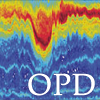
|
John Dunlap Senior Principal Engineer dunlap@apl.washington.edu Phone 206-543-7207 |
Research Interests
Oceanographic Measurement Systems
Biosketch
John Dunlap provides the real-time data acquisition firmware for many oceanographic instruments. All are used to estimate the ocean's water velocity using electric field measurements in the ocean. Another of John's interests is automatic determination of hard and soft iron near instrument compasses using in-situ data. The result is a compass calibration that can be determined in one location and used anywhere in the world.
His data acquistion systems using Linux have recorded time-stamped serial data from many diverse instruments aboard ship to provide real-time synchronized data from a broad array of instrumentation aboard research ships to support oceanographic cruises. Mr. Dunlap has been with the Laboratory since 1979.
Education
B.S. Electrical Engineering, University of Rochester, 1969
|
Publications |
2000-present and while at APL-UW |
Autonomous control of marine floats in the presence of dynamic, uncertain ocean currents Troesch, M., S. Chien, Y. Chao, J. Farrara, J. Girton, and J. Dunlap, "Autonomous control of marine floats in the presence of dynamic, uncertain ocean currents," Rob. Auton. Syst., 108, 100-114, doi:10.1016/j.robot.2018.04.004, 2018. |
More Info |
1 Oct 2018 |
|||||||
|
A methodology is described for control of vertically profiling floats that uses an imperfect predictive model of ocean currents. In this approach, the floats have control only over their depth. This control authority is combined with an imperfect model of ocean currents to attempt to force the floats to maintain position. First, the impact of model accuracy on the ability to station keep (e.g. maintain X–Y position) using simulated planning and nature (ground-truth in simulation) models is studied. In this study, the impact of batch versus continuous planning is examined. In batch planning the float depth plan is derived for an extended period of time and then executed open loop. In continuous planning the depth plan is updated with the actual position and the remainder of the plan re-planned based on the new information. In these simulation results are shown that (a) active control can significantly improve station keeping with even an imperfect predictive model and (b) continuous planning can mitigate the impact of model inaccuracy. Second, the effect of using heuristic path completion estimators in search are studied. In general, using a more conservative estimator increases search quality but commensurately increases the amount of search and therefore computation time. Third are presented results from an April 2015 deployment in the Pacific Ocean that show that even with an imperfect model of ocean currents, model-based control can enhance float control performance. |
|||||||||
The EM-POGO: a simple, absolute velocity profiler Terker, S.R., T.B. Sanford, J.H. Dunlap, and J.B. Girton, "The EM-POGO: a simple, absolute velocity profiler," Deep Sea Res. II, 85, 220-227, doi: 10.1016/j.dsr2.2012.07.026, 2013. |
More Info |
1 Jan 2013 |
|||||||
|
Electromagnetic current instrumentation has been added to the Bathy Systems, Inc. POGO transport sondes to produce a free-falling absolute velocity profiler called EM-POGO. The POGO is a free-fall profiler that measures a depth-averaged velocity using GPS fixes at the beginning and end of a round trip to the ocean floor (or a pre-set depth). The EM-POGO adds a velocity profile determined from measurements of motionally-induced electric fields generated by the ocean current moving through the vertical component of the Earth's magnetic field. In addition to providing information about the vertical structure of the velocity, the depth-dependent measurements improve transport measurements by correcting for the non-constant fall-rate. Neglecting the variable fall rate results in errors O(1 cm s-1). The transition from POGO to EM-POGO included electrically isolating the POGO and electric-field-measuring circuits, installing a functional GPS receiver, finding a pressure case that provided an optimal balance among crush-depth, price and size, and incorporating the electrodes, electrode collar, and the circuitry required for the electric field measurement. The first EM-POGO sea-trial was in July 1999. In August 2006 a refurbished EM-POGO collected 15 absolute velocity profiles; relative and absolute velocity uncertainty was ~ 1 cm s-1 and 0.5–5 cm s-1, respectively, at a vertical resolution of 25 m. Absolute velocity from the EM-POGO compared to shipboard ADCP measurements differed by ~ 1–2 cm s-1, comparable to the uncertainty in absolute velocity from the ADCP. The EM-POGO is thus a low-cost, easy to deploy and recover, and accurate velocity profiler. |
|||||||||
Autonomous velocity and density profiler: EM-APEX Sanford, T.B., J.H. Dunlap, J.A. Carlson, D.C. Webb, and J.B. Girton, "Autonomous velocity and density profiler: EM-APEX," Proceedings, IEEE/OES Eighth Working Conference on Current Measurement Technology, 152-156, doi:10.1109/CCM.2005.1506361, (IEEE, 2005) |
More Info |
30 Jul 2005 |
|||||||
|
We developed an autonomous ocean profiling velocity and density float that provides exceptional vertical coverage and temporal resolution to depths of 2000 m for deployments of many years. Electrodes were added to the exterior of standard WRC APEX floats, and electronics were added inside. The electrode voltages result from the motion of seawater and the instrument through the Earth's magnetic field. Other systems included magnetic compass, tilt, CTD, GPS, and Iridium (providing sampling/mission changes). Three EM-APEX floats were deployed from a C-130 aircraft ahead of Hurricane Frances. The floats profiled for 10 hr from the surface to 200 m, then continued profiling between 30 m and 200 m with excursions to 500 m every half inertial period. The velocity computations were performed onboard and saved for later transmission. After five days, the floats surfaced and transmitted the accumulated processed observations, then the floats profiled from 500 m every half inertial period until recovered early in October located by GPS and Iridium. |
|||||||||






